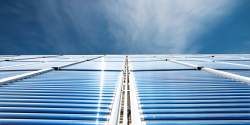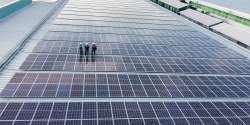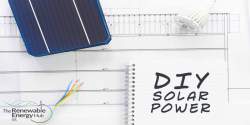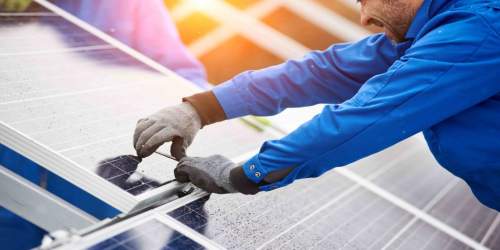Read Time : 3 Minutes
How to Calculate Solar Panel Size Needed
If you are looking into purchasing solar panels to be installed on your roof, then you are in for a fantastic experience. They are a brilliant way to provide energy for your home and lower your annual energy bills in one go. Plus, they are environmentally friendly and require hardly any maintenance. However, before you buy, it is important to have a rough idea of the panel size and amount that you will need. Make sure you consult a professional and accredited installer about this, but this page can act as a rough guide.
Your Budget
Generally speaking, the size (in kW) of the array is limited by two factors, space and budget. If your roof is small, then there will be a limit of the amount of power you can generate. you can squeeze more out of this available roof space by installing more expensive panels that generate more energy per m2. Residential systems over 4kW will require an additional surveys that can delay an installation, but don’t let that deter you as the benefits will outweigh the time and cost in most circumstances.
COMPARE PRICES FROM LOCAL INSTALLERS
Compare prices from local companies fast & free
Enter your postcode to compare quotes from leading professionals. We promise to keep your information Safe & Secure. Privacy Policy
The Energy Requirements for Your Home
The first thing you need to do is take a look at how much energy your home uses. You can do this by taking past electricity bills and looking for an average usage. You will want this to be a daily average, so if your bill does not show this then divide it accordingly. So, if it is monthly, divide it by 30, and if it is annual, divide it by 365. Your answer will also be in kilowatt hours (kWh). This is how much power you are using at any given time, multiplied by the total time the power is used for. So, if you run a 60w light bulb all day, you will be using around 1,440 watts, or 1.4kWh.
What is Your Target Daily Average?
The thing with solar panels is that they will not work at full efficiency all the time. It could be a cloudy day; they could have some unexpected shade – there are a number of reasons as to why this could happen. As a result, experts recommend that you leave a cushion of 25% when it comes to calculating how much energy you will use on a daily basis. This allows you to offset any inefficiencies that may occur.
How Much Sunlight Do You Receive?
Generally speaking, the peak hours of sunlight are between 9am and 3pm each day, although there can be variations depending on your location. Some areas will have more light than others, and there can be a bit of a difference between the north and south of the United Kingdom. However, this does not mean that you won’t have less energy production if you live in a shadier area, it just means that you might need more panels in order to fully benefit. What you can do for a rough estimate is divide you daily kWh usage by the number of peak sunlight hours in a day. This will leave you with the amount of energy you need to produce in kWh. You can multiply this number by 1000 for the watt usage. Of course, you should also consult your installer about this.
​How Many Panels?
There is quite a difference when it comes to the capabilities and performance levels of solar panels, and so the quality can really make a difference. PV solar panels tend to vary between 150w to 345w per panel, depending on the size of it and the cell technology use to create each of the modules. To calculate the number of panels you need, divide the hourly energy usage of your home by the wattage of the solar panels. You should do this for a low and high wattage option, as this will allow you to create a range of sizes, giving you realistic expectations. What this does is give you an estimate for the number of panels that you need to generate electricity. After this, a professional installer will come and access your roof, determining which angle is best, as well as how the panels would be arranged on your roof.
The Cost of Solar Panels Per Square Foot
It can be difficult to determine how much solar panels will cost you per square foot. This is because there are several factors such as size, type, and quality, that will affect the total cost of the panels. However, it is possible for a tough calculation to be given for the cost per square foot. The prices below include the following:
- Panels
- Installation
- Additional equipment
- Warranty
- Certificate
Here are some example of systems and how much you should be looking to spend.
This will cover an estimated 150 square feet. If we are looking at a mid-range system, then the average cost would be £2,775. This means that the system would cost you around £18.50 per square foot.
This will cover an estimated 225 square feet. Looking at a mid-range system once again, the average cost for this would be around £5,000 in total. This works out to £22,12 per square foot.
- 4kw System
This would cover an estimated 301 square feet. Taking another kid-range system, it would cost around £7,000 to install. As a result of this, the cost per square foot would be £23.26.
Solar Panel Size Per kWH
What you can expect from a solar panel system is for it to produce between 9 and 11kwh per square feet each year. This means that is you have a 1kw system covering 86 square feet, you will be able to use around 850kwh of electricity per year. Alternatively, a 4kw system that uses 301 square feet of space will allow you to use 3,400kwh of electricity per year.
Want to Know More?
Have you found yourself interested in solar panels? If you want to know more then make sure you head to our marketplace where you can find our full range of products, each with the relevant information. Or simply give us a ring using the number at the top of this page and have a chat. We have specialist software that will calculate the exact system and its output and the varying costs associated with using different gear on your roof.
Find a local installer
Welcome to the biggest directory of UK renewable energy companies





 How Much do Solar Panel Systems Cost in 2024?
How Much do Solar Panel Systems Cost in 2024?







